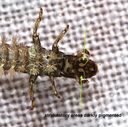Hydropsychinae
Hydropsychinae
Classification
- Phylum: Arthropoda
- Subphylum: Hexapoda
- Class: Insecta
- Order: Trichoptera
- Suborder: Annulipalpia
- Superfamily: Hydropsychoidea
- Family: Hydropsychidae
- Subfamily: Hydropsychinae
Pronunciation
How to pronounce Hydropsychinae: /ˌhaɪdrəˈsaɪkɪniː/
These audio files are automatically generated. While they are not always 100% accurate, they are a good starting point.
Images






Summary
Hydropsychinae is a subfamily of net-spinning caddisflies known for their ecological role in freshwater habitats and their unique silk-spinning behavior. They are important for their contributions to the ecosystem and serve as indicators of water quality.
Physical Characteristics
Net-spinning caddisflies with a range of physical forms that typically include elongated bodies and wings adapted for spinning nets.
Identification Tips
Look for silk nets in freshwater habitats, which are a signature of this group, along with their characteristic elongated bodies and wings.
Habitat
Freshwater habitats such as streams and rivers, often in clean, flowing waters.
Distribution
Worldwide, with a concentration in temperate regions.
Diet
Most members are detritivores, feeding primarily on organic matter and microorganisms trapped in their silk nets.
Life Cycle
Undergo complete metamorphosis with egg, larval, pupal, and adult stages. Larvae are aquatic and build nets in the water.
Reproduction
Mating occurs aerially, and females lay eggs in or near water bodies. Eggs hatch into aquatic larvae.
Predators
Fish, amphibians, and other aquatic invertebrates.
Ecosystem Role
Important players in freshwater ecosystems, serving as indicators of water quality and contributing to nutrient cycling.
Cultural Significance
Part of the biodiversity in freshwater ecosystems, influencing local ecology and sometimes fisheries indirectly.
Collecting Methods
- Sampling with nets in freshwater environments
- Suction sampling
- Light traps for adult collection
Preservation Methods
- Ethanol preservation for aquatic larvae
- Pinned specimens for adults
Similar Taxa
- Other subfamilies of caddisflies
- Hydropsychidae
Misconceptions
Often confused with other similar aquatic insects; their silk nets can be mistaken for spider webs.
Tags
- Insecta
- Caddisflies
- Freshwater
- Ecosystem
- Biodiversity